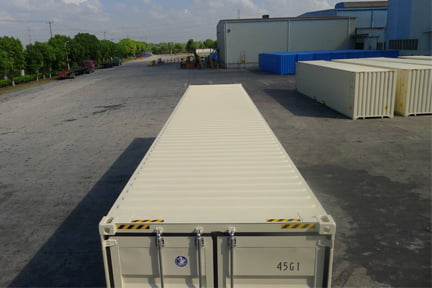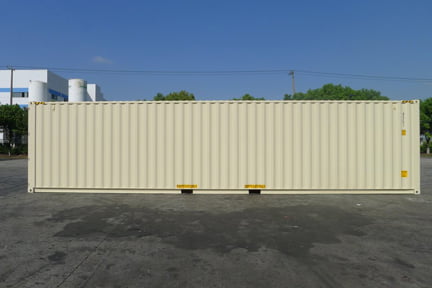What is a Dry Container?
A dry container is one of the most common types of shipping containers used globally for transporting general cargo. It falls under the category of standard shipping containers, which are specifically designed to safely store and transport dry, non-perishable goods across long distances.
Dry containers are fully enclosed, weatherproof, and have rigid walls and doors that protect goods from the elements. Unlike other types of containers that may have built-in refrigeration or ventilation for specific cargo needs, dry containers are typically used for goods that do not require temperature control, such as manufactured products, electronics, furniture, and textiles.
ISO Standards for Shipping Containers
The design and dimensions of standard shipping containers are governed by the International Organization for Standardization (ISO). The ISO sets rigorous standards to ensure consistency and safety in the manufacturing and use of these containers globally. Compliance with ISO standards means that containers can be used interchangeably across different transportation systems and regions, facilitating seamless international trade. For more detailed information, you can visit the ISO website.
Benefits of Using Standard Shipping Containers
1. Efficiency: The uniform size and shape of standard containers streamline loading and unloading processes, reducing handling time and labor costs.
2. Cost-Effectiveness: By minimizing the need for repackaging and reducing the risk of cargo damage, standard containers help lower transportation costs.
3. Environmental Impact: Using standard containers for intermodal transport can reduce fuel consumption and emissions by optimizing space and weight distribution on transport vehicles.
4. Global Trade Facilitation: Standard containers are essential for international shipping, allowing goods to be transported smoothly and efficiently across borders.directly into Dry containers, minimizing the need for additional packaging and saving on packing costs.
To discuss your container needs, get in touch with Global Container and Chassis immediately to check the container for sale near you. We sell new and used shipping containers. Our experienced and knowledgeable team is ready to provide you with expert guidance and help you find the ideal storage solution.
Key Features of Standard Shipping Container
1. Uniform Dimensions: Standard shipping containers come in specific sizes, most commonly 20 feet and 40 feet in length. The standardized dimensions facilitate easy stacking and efficient use of space on transportation vessels and storage facilities.
2. Durability: Made from robust materials like steel or aluminum, these containers are built to withstand harsh environmental conditions during transit, including extreme weather, rough handling, and long-term exposure to saltwater.
3. Security: Standard containers are equipped with secure locking mechanisms to protect the cargo from theft and tampering. They are designed to be sealed, ensuring the contents remain intact from the point of origin to the destination.
4. Versatility: These containers can be used to transport a wide range of goods, including raw materials, finished products, and perishable items when equipped with refrigeration units (referred to as reefer containers).
| Container Size | Interior Dimensions (L x W x H) | Payload Capacity | Tare Weight | Cubic Capacity |
|---|---|---|---|---|
| 20ft | 19.4ft x 7.8ft x 7.9ft | 25,000 kg (55,126 lbs) | 2,300 kg (5,071.5 lbs) | 33.2 cubic meters (1,172 cubic feet) |
| 20ft High Cube | 19.4ft x 7.7ft x 8.9ft | 28,160 kg (62,082 lbs) | 2,315 kg (5,103.7 lbs) | 37.28 cubic meters (1,316 cubic feet) |
| 40ft | 39.5ft x 7.9ft x 7.9ft | 27,600 kg (61,200 lbs) | 3,750 kg (8,268.8 lbs) | 67.7 cubic meters (2,389 cubic feet) |
| 40ft High Cube | 39.5ft x 7.8ft x 8.10ft | 28,600 kg (63,052 lbs) | 3,900 kg (8,598 lbs) | 76.3 cubic meters (2,694.5 cubic feet) |
| 45ft High Cube | 44.5ft x 7.8ft x 8.10ft | 27,700 kg (61,067 lbs) | 4,800 kg (10,552 lbs) | 86 cubic meters (3,037 cubic feet) |
Applications of shipping containers
Shipping containers have a wide range of applications beyond just transporting goods. They are used extensively in various industries due to their durability, versatility, and cost-effectiveness.
1. Intermodal Transportation: Shipping containers play a vital role in intermodal transportation, enabling goods to be moved seamlessly between ships, trains, and trucks without the need for unloading and reloading. This efficiency significantly reduces handling costs and time.
2. Storage Solutions: Many businesses and individuals utilize shipping containers for secure, weather-resistant storage. Their robust construction makes them ideal for storing tools, equipment, and even household items, ensuring protection against environmental elements.
3. Construction Projects: Shipping containers are increasingly popular in construction projects as modular units. They can be transformed into offices, homes, and retail spaces, offering innovative and sustainable building options that are both cost-effective and environmentally friendly.
4. Emergency Relief: In disaster-stricken areas, shipping containers are often repurposed as temporary shelters, medical clinics, and storage for relief supplies. Their quick deployment and sturdiness make them an excellent choice for emergency relief operations.
5. Pop-Up Shops and Restaurants: Entrepreneurs and small businesses are using shipping containers to create pop-up shops and restaurants. These containers provide a unique, mobile, and cost-effective way to set up business operations, attracting customers with their distinctive design.
6. Agriculture: Shipping containers are being utilized in urban farming and hydroponics to create controlled environments for growing plants. This method maximizes space and resources, making it possible to cultivate crops in urban areas or regions with harsh climates.
7. Art Installations and Exhibits: Artists and curators are repurposing shipping containers as mobile galleries and exhibition spaces. Their portability and unique aesthetic make them ideal for showcasing art in various locations and settings.
8. Mobile Workshops: Shipping containers can be converted into mobile workshops for tradespeople and craftsmen. These portable units provide a secure, dedicated space for work, complete with tools and equipment.
9. Data Centers: Tech companies are repurposing shipping containers into modular data centers. These compact, scalable units can be quickly deployed to provide computing power and storage in various locations, enhancing flexibility and efficiency.
10. Event Spaces: Shipping containers are being used to create innovative event spaces for concerts, festivals, and conferences. Their modular nature allows for creative layouts and designs, offering unique experiences for attendees.
Discover more about these applications on Container xChange Blog.
Contact us to check the container for sale near you.
Container Categories
- One-Tripper
- IICL-5 Containers
- Cargo Worthy
- Wind and Water-Tight (WWT)
- As is or General Purpose
- Refurbished
- Damage Container








